White coating on cucumber leaves, stems, or fruits is a common issue faced by gardeners. The condition is primarily fungal in nature — plant tissues are affected by fungi that cause whitish, yellow, or gray fuzzy coatings. Let’s explore why white mold appears on cucumbers, how dangerous it is, and whether powerful chemical treatments are always necessary to eliminate it.
Table of contents
Causes of White Coating on Cucumber Leaves, Stems, and Fruits
Cucumbers are one of the most popular vegetable crops among gardeners. However, their cultivation often comes with challenges like white mold on stems, leaves, and fruits. The main causes include:
- sudden fluctuations in daily temperatures;
- prolonged rainfall;
- watering with cold water;
- overcrowded planting;
- excessive humidity in greenhouses;
- poor agricultural practices (weeding, loosening);
- lack of sunlight;
- excess nitrogen in the soil;
- deficiency of phosphorus and potassium.
These cultivation issues lead to fungal diseases and the spread of pests.
Diseases and Pests Causing White Coating
Diseases causing whitish or yellow coatings on cucumber leaves are mostly fungal (powdery mildew, downy mildew, white rot, ascochyta blight). Cucumber mosaic virus is a viral disease.
Spider mites, which feed on plant tissues, also cause white spots on leaves — a result of disrupted photosynthesis in damaged areas.
Powdery Mildew
Powdery mildew is a fungal disease caused by ectoparasites. In late May or early June, white mycelium develops on young shoots and leaves. Small droplets of sticky, cloudy dew appear on plants.
The pathogen overwinters in the topsoil and plant debris, spreading from lower leaves upward in spring.
Symptoms:
- whitish coating on leaves and stems;
- brown specks inside the coating;
- dew droplets on foliage;
- dry, curled leaves;
- rot on fruits.
Without treatment, the coating thickens, turns brown, and spreads across the plant. Cucumbers appear moldy, indicating the final disease stage. Treatment is ineffective at this point.
Photo of powdery mildew:
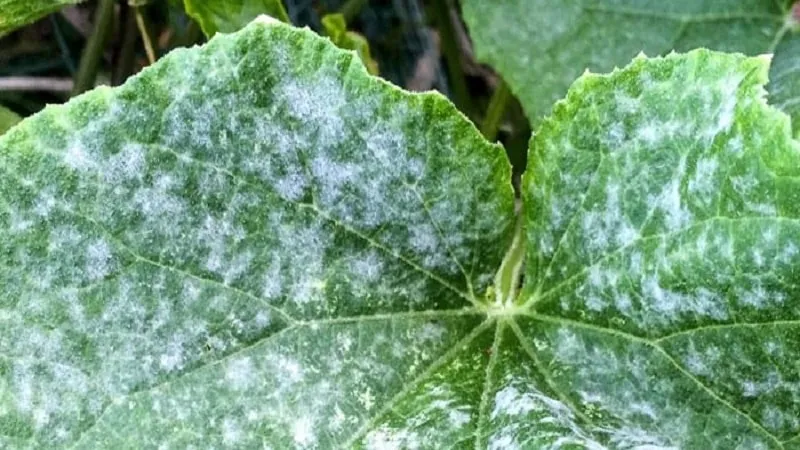
The table below lists effective home remedies for powdery mildew.
| Recipe | Application |
| 10 L water, 1 L yogurt, kefir, or whey. | Apply daily until the disease is eradicated. |
| 1 L water, 0.3 tsp baking soda, 25 mL liquid soap. | Spray plants once every 7 days. |
| 1 L wood ash soaked in 5 L boiling water for 24 hours. | Treat plants weekly. |
| Cow manure infusion (1:10), fermented for 3 days. | Water at the base in the evening once a week. |
| 100 g dried horsetail soaked in 10 L water for 24 hours, boiled for 2 hours, strained, and cooled. Dilute 1:5 with water. | Spray weekly. |
| 0.5 bucket of marigold flowers soaked in warm water for 48 hours, add 50 g grated soap. | Treat plants twice a week. |
Effective chemical treatments:
| Name | Application | Toxicity |
| «Topsin» | 2 mL dissolved in 10 L water, then diluted further. First treatment after 8-10 true leaves appear, second at flowering onset (10 days later). | Non-phytotoxic; safe for birds, fish, beneficial insects, and humans. |
| «Benomyl» | 10 g per 10 L water. Apply at least three times, 10 days apart. | Moderately toxic to insects and humans. |
| «Copper Oxychloride» | 40 g powder in 10 L water, add 100 mL skim milk. Spray weekly in the evening. | Non-phytotoxic; safe for wildlife and humans. |
| «Score» | 2 mL per 10 L water. Apply three times, 10-12 days apart. | Non-phytotoxic; safe for wildlife and humans. |
| «Thiovit Jet» | 30 g per 10 L water. Apply 2-3 times per season. | Non-phytotoxic; safe for wildlife and humans. |
Downy Mildew (Peronospora)
Downy mildew appears as white-yellow oily spots on cucumber leaves. As it progresses, the underside develops a purple coating. Spots enlarge and merge, leaves wrinkle, dry, and die. Without treatment, downy mildew can destroy entire crops.
Note: Downy mildew thrives in prolonged rain, cold watering, and excessive soil moisture.
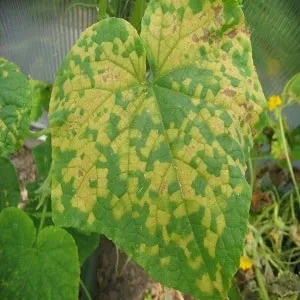
Home remedies for downy mildew:
| Recipe | Application |
| 5 L water, 40 g baking soda, 50 g grated soap. | Spray soil and plants four times per season (weekly intervals). |
| 1 L skim milk, 40 drops iodine, 25 mL liquid soap. | Spray regularly throughout the growing season (10-day intervals). |
| 0.5 kg onion husks boiled in 10 L water, steeped for 5-7 days. | Apply 3-5 times monthly until symptoms disappear. |
Chemical treatments for downy mildew:
| Name | Application | Toxicity |
| «Acrobat MZ» | 50 g per 10 L water. Apply at first symptoms, repeat after 2 weeks. | Safe for birds, fish, and humans. |
| «Alirin B» | 2 tablets per 10 L water (for soil drenching).
1 tablet per 1 L water (for foliar spray). Apply 2-3 times per season. |
|
| «Oxycom» | 30 g per 10 L water. Spray in the evening. Apply three times (15-day intervals). | |
| «Ordan» | 25 g per 10 L water. Apply at first symptoms, repeat after 2 weeks. |
White Rot (Sclerotinia)
White rot is caused by the fungus Sclerotinia. Spores penetrate plant tissues, forming cotton-like white mold on cucumbers, stems, and leaves. Infected areas become watery; shoots and leaves wilt and die.
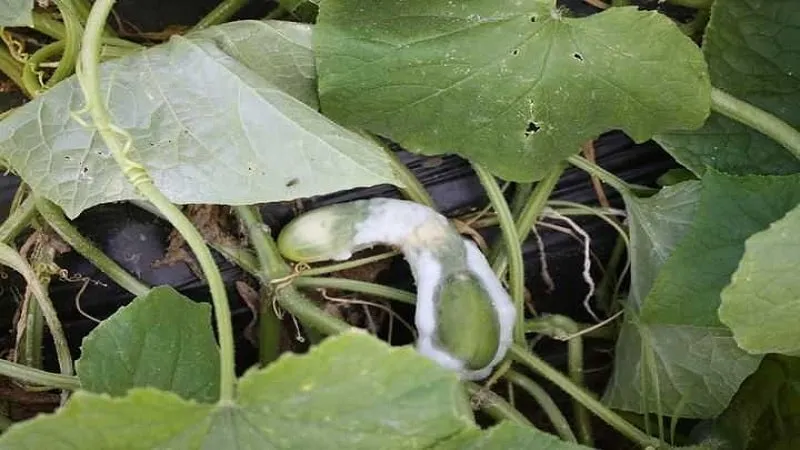
Home remedies for white rot:
| Recipe | Application |
| 1 L milk, 1 tbsp grated soap, 30 drops iodine, 10 L water. | Spray plants 3-4 times weekly. |
| 10 L water, 8 tbsp soda, 4 tsp potassium permanganate, 1 tbsp grated soap. | Apply weekly. |
| Mix wood ash and crushed chalk (1:1), add water for a paste. | Cut infected leaves/stems, apply paste to cuts. |
Chemical treatments for white rot:
| Name | Application | Toxicity |
| «Abiga-Peak» | 50 mL per 10 L water. Apply three times over 20 days. | Safe for humans and the environment. |
| «Acrobat MZ» | 20 g per 5 L water. Apply twice (10-day intervals). | |
| «Ridomil Gold» | 25 g per 10 L water. Apply three times (weekly intervals). |
Gray Mold
Gray mold, caused by Botrytis cinerea, leads to whitish-gray coatings on fruits, leaves, and stems. Infected areas rot and die. Cucumbers become watery inside and develop gray fuzzy mold.
Home remedies work only in early stages or for prevention.
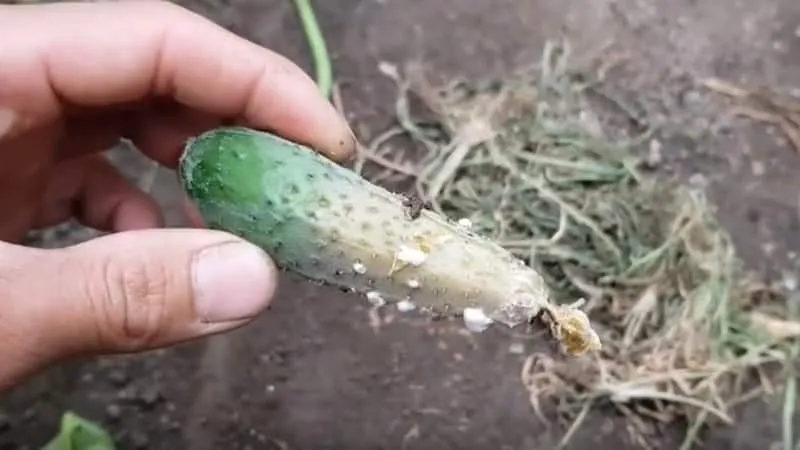
| Recipe | Application |
| 50 g baking soda, 80 g copper sulfate, 50 g grated soap per 10 L water. | Spray plants three times weekly. |
| 2 tsp brilliant green, 1.5 tsp potassium permanganate, 25 mL liquid soap per 10 L water. | Apply 2-3 times weekly. |
| 10 g boric acid, 1.5 g potassium permanganate, 30 mL iodine, 50 g grated soap per 10 L water. | Spray 3-4 times weekly. |
Chemical treatments for gray mold:
| Name | Application | Toxicity |
| «Copper Oxychloride» | 40 g per 10 L water + 100 mL skim milk. Spray weekly in the evening. | Safe for humans and insects. |
| «Rovral» | Mix powder with lime/chalk (1:1 or 2:1), apply to infected stems three times monthly. | |
| «Euparen Multi» | 0.2% solution. Spray every 14 days. |
Cucumber Mosaic Virus
Cucumber mosaic virus progresses as follows:
- lightening along leaf veins;
- star-shaped spots and yellow rings;
- spreading white-yellow patches on leaves and fruits.
No effective treatment exists. Remove and burn infected plants.
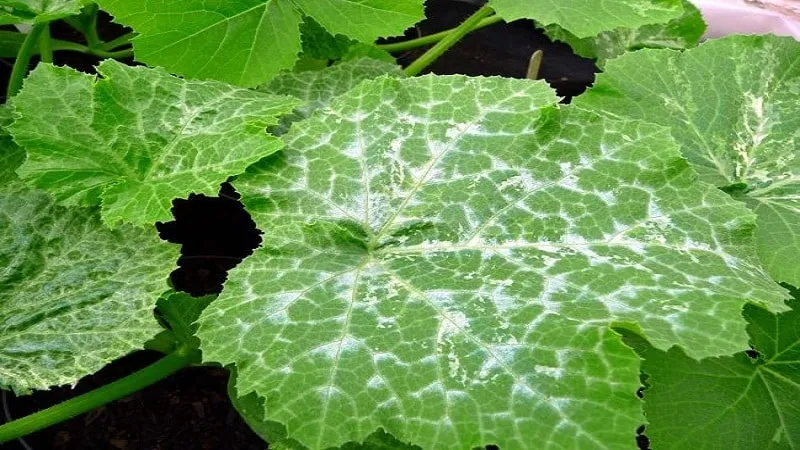
Ascochyta Blight
Ascochyta blight is a severe fungal disease causing plant death. The fungus spreads from stems, leaving leaves unaffected initially. Leaves show symptoms during fruiting.
Symptoms:
- vague brown-to-white-yellow spots on leaf edges;
- raised spots containing spores;
- dried, dead leaves.
The fungus doesn’t multiply in soil but infects seeds. Prevention involves seed treatment before planting.

Seed treatments before planting:
| Name | Application |
| «Baxis» | Soak seeds in 0.2% suspension for 2 hours. |
| «Planriz» | Soak seeds in 1% solution for 6 hours. |
| «Fitosporin-M» | Soak seeds in working solution for 2 hours. |
No home remedies exist for ascochyta blight.
Spider Mites
Spider mites feed on plant tissues, attacking cucumbers in open and protected ground.
Key signs are tiny white dots on leaf undersides, followed by fine webbing. Severe infestations turn leaves white from damage, with mites visible on stems.
Chemical treatments are last-resort solutions due to toxicity. Rotate products to prevent resistance.
Spray in the evening to avoid leaf burn.
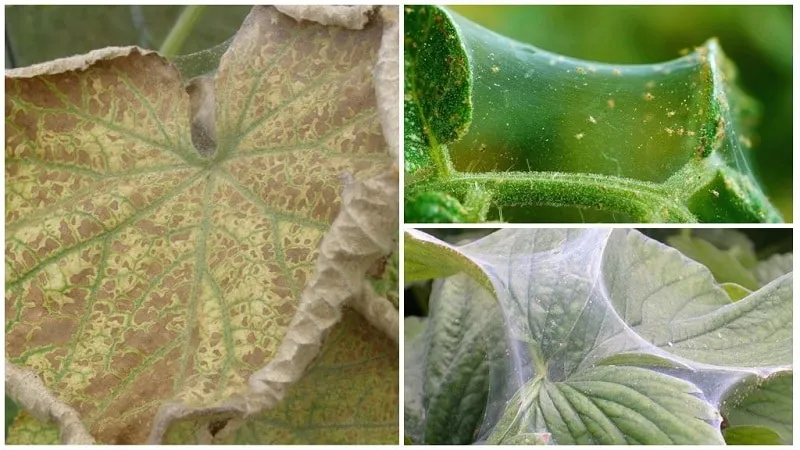
Effective miticides: Stop applications 20 days before harvest.
| Name | Application | Protection Period | Frequency |
| «Plant Pin» | Insert sticks into soil near plants. | 6 weeks | Once |
| «Malathion» | 70 g per 10 L water (0.5 L per plant). | 7 days | Twice |
| «Floramite» | 5 mL per 10 L water (1 L per plant). | 30 days | Once |
| «Actellic» | Highly toxic. Best against mites.
2 mL in 2 L water (use immediately). 2 L per 10 m². |
10-12 days | Twice |
Home remedies for spider mites:
| Recipe | Application |
| 0.5 bucket potato tops soaked in water for 5-7 hours, add 50 g grated soap. | Spray weekly. |
| 30 g dandelion roots soaked in 1 L water for 5 hours. | Spray twice weekly. |
| 1 kg hogweed soaked in 10 L water for 24 hours. | Spray weekly. |
| 2 garlic heads soaked in 1 L water for 7 days, dilute 1:2 before use. | Spray 1-2 times weekly. |
| 100 g common datura soaked in 1 L water for 10-12 hours. | Spray weekly. |
| 100 g creeping mustard soaked in 1 L water for 12 hours, dilute 1:2 before use. | Spray every 7-10 days. |
Prevention
Preventive measures against white mold:
- Regular weed and debris removal.
- Crop rotation. Plant cucumbers after cabbage, legumes, corn, onions, or garlic.
- Pre-plant soil treatment with «Alirin-B» or «Gamair».
- Disinfect planting holes with hot potassium permanganate.
- Monitor soil nitrogen levels.
- Choose disease-resistant cucumber varieties.
- Avoid overcrowding.
- Preventive sprays with «Fitosporin», «Cuprolux», or «Ordan».
- Select sunny, draft-free sites.
- Apply potassium and phosphorus fertilizers.
- Use drip irrigation to avoid wet foliage.
- Frequent soil loosening.
- Greenhouse disinfection with sulfur bombs.
- Maintain greenhouse humidity (below 80-85%).
- Control temperature (optimum: +25…+27°C).
- Replace topsoil annually.
Conclusion
White mold on cucumbers results from fungi causing powdery mildew, downy mildew, ascochyta blight, and rots. Effective chemicals include «Copper Oxychloride», «Oxycom», «Ridomil Gold», «Acrobat MZ», «Alirin B», and «Ordan». Home remedies (onion husks, milk, iodine, marigolds) work early-stage or preventively.
No treatments exist for cucumber mosaic virus. Follow cultivation best practices to prevent infection.
For spider mites, use «Actellic», «Malathion», «Plant Pin», or «Floramite». Home remedies support control.







